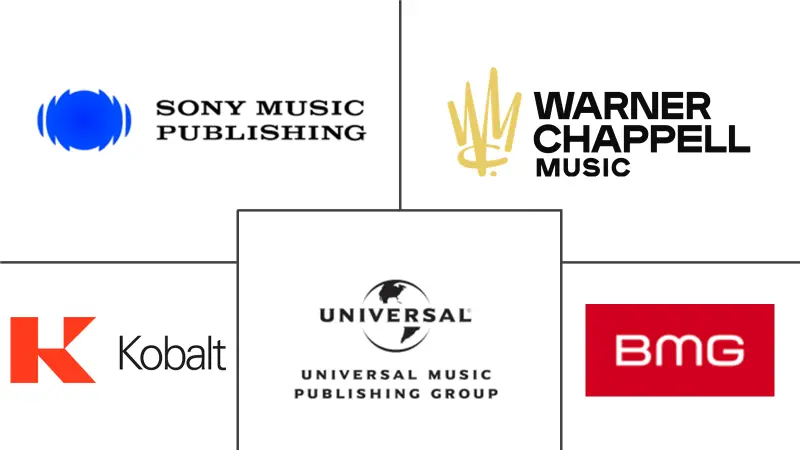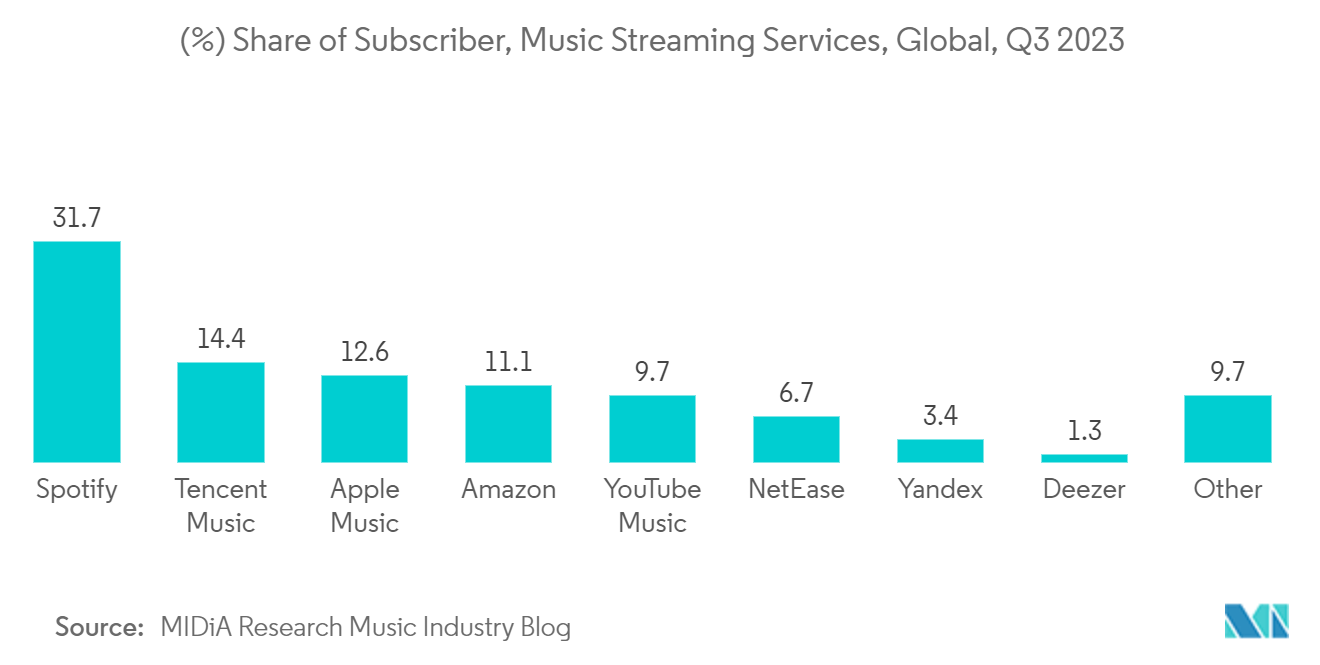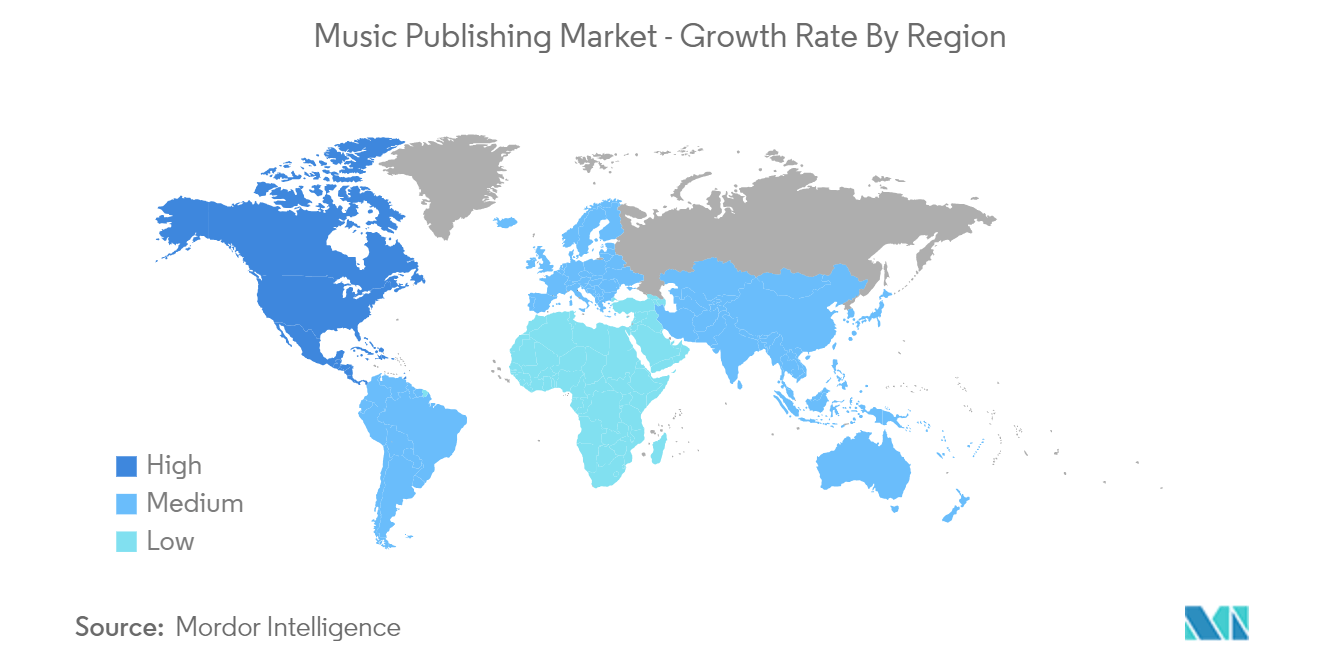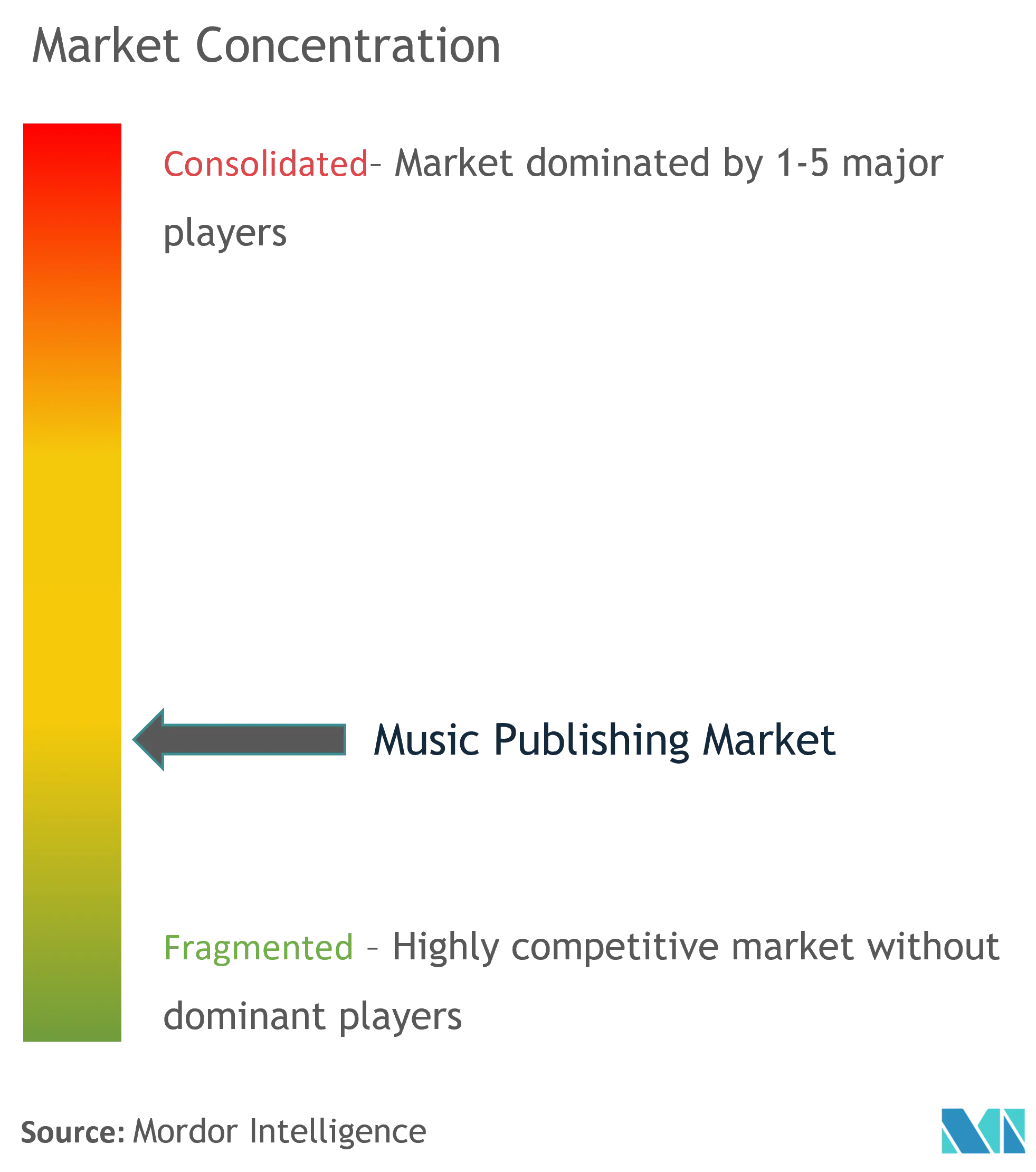Music Publishing Market Size

| Study Period | 2019 - 2029 |
| Market Size (2024) | USD 7.26 Billion |
| Market Size (2029) | USD 9.66 Billion |
| CAGR (2024 - 2029) | 5.87 % |
| Fastest Growing Market | Latin America |
| Largest Market | North America |
Major Players
*Disclaimer: Major Players sorted in no particular order |
Music Publishing Market Analysis
The Music Publishing Market size is estimated at USD 7.26 billion in 2024, and is expected to reach USD 9.66 billion by 2029, growing at a CAGR of 5.87% during the forecast period (2024-2029).
- The music publishing market, a pivotal component of the music industry, revolves around managing and owning musical compositions. It involves licensing songs for various media, spanning from films and TV to digital platforms and ads. Music publishers are instrumental in ensuring that songwriters and composers receive due royalties. This entails registering works with performance rights organizations, negotiating licenses, and handling royalty collection and distribution. The industry has transformed with digital technology, broadening avenues for monetizing music.
- Digital streaming services, notably platforms like Spotify, Apple Music, and YouTube, are key drivers for the growth of the music publishing market. These services have revolutionized music consumption, spurring a heightened demand for licensed music. As streaming dominates music consumption, publishers are adapting by crafting new licensing agreements tailored for digital music distribution. However, this shift brings challenges, such as ensuring equitable compensation for songwriters and navigating intricate international copyright laws.
- The music publishing market is witnessing substantial consolidation, with industry giants like Sony/ATV, Universal Music Publishing Group, and Warner/Chappell at the forefront. These major players have been acquiring smaller publishers and catalogs, bolstering their global influence. While this consolidation can streamline operations and enhance bargaining power, it also raises concerns about reduced competition and limited opportunities for independent songwriters and smaller publishers.
- Technological advancements are reshaping the music publishing landscape. Blockchain technology, for example, has the potential to revolutionize royalty tracking by offering a transparent ledger of music rights. Furthermore, artificial intelligence and machine learning are aiding in analyzing music consumption patterns, empowering publishers to predict trends and make strategic licensing decisions. These innovations are poised to boost royalty payment efficiency, benefiting both publishers and creators.
- Despite these advancements, the music publishing industry grapples with persistent challenges, notably copyright infringement and piracy. The digital era has amplified unauthorized music use and distribution, jeopardizing publishers' and songwriters' revenues. To counter this, the industry is advocating for stricter copyright laws and enhanced enforcement. Moreover, as music consumption globalizes, the push for harmonized global copyright regulations may gain significance. Tackling these challenges is imperative for the sustained growth of the music publishing industry.
Music Publishing Market Trends
Growth of Digital Streaming is Driving the Music Publishing Market
- The growth of digital streaming has reshaped the music publishing landscape, transforming how music is consumed, monetized, and managed. Platforms such as Spotify, Apple Music, and YouTube have dominated music consumption, overshadowing traditional sales and downloads. This surge in demand for licensed music, driven by rising subscriptions, has translated into higher royalties for publishers and songwriters. Consequently, publishers are adapting and focusing on digital distribution in their licensing agreements.
- Streaming's influence on music publishing has gone beyond revenue. Platforms have collected vast amounts of data on listener behavior, empowering publishers to grasp music trends and profitability. Armed with this data, publishers have refined promotions, acquired suitable catalogs, and structured licensing deals. This data-driven approach has not only sharpened revenue strategies but also enhanced the market's responsiveness to consumer preferences.
- According to a Survey by MIDiA Research in Q3 of 2023, Spotify dominated the streaming subscriber market with a 31.7% share, more than double that of Tencent Music, the second-ranked service. Apple Music, Amazon, and YouTube also held significant positions.
- Digital platforms have not only expanded the reach of music publishing but also broken down traditional geographic barriers. This globalization has fostered cross-border collaborations and licensing deals, driving growth in international markets. Publishers have diversified their catalogs to appeal to a wider audience, thereby increasing their revenue potential.
- Streaming has not just been about consumption. It is a potent tool for music discovery and promotion. Curated playlists, algorithms, and user-generated content have democratized music exposure, offering independent artists a level playing field. Publishers have played a crucial role, ensuring their songs secure prominent playlist placements, leading to increased royalties.
- With streaming at the forefront of music consumption, publishers have overhauled their business models. As physical sales have declined, publishers have pivoted to streaming as their primary revenue source. This shift has prompted the development of new licensing and revenue-sharing models, aligning with the digital era. By adapting swiftly and embracing technological advancements, publishers have been well-positioned to excel in this increasingly digital-centric industry.

North America Accounts for a Significant Share in the Market
- North America, led by the United States, commands a substantial portion of the global music publishing market, driven by its expansive and well-established music industry. The region's dominance is underscored by a dense presence of music publishers, record labels, and a robust network of distributors and streaming platforms. Key cities like Los Angeles, Nashville, and New York serve as epicenters for music production and publishing, housing numerous influential entities. This clustering not only fosters significant revenue but also solidifies North America's market supremacy.
- Leading music publishing entities headquartered in North America, particularly in the United States, are pivotal in bolstering the region's market standing. Powerhouses like Universal Music Publishing Group, Warner/Chappell Music, and Sony/ATV Music Publishing boast extensive music catalogs and global networks, granting them substantial market influence. Their dominance cements North America's pivotal role in the global music publishing landscape.
- With its stringent copyright laws, North America's robust legal framework, especially in the United States, is instrumental in upholding the region's market share. The United States boasts comprehensive copyright legislation that safeguards the rights of music creators and publishers. Entities like the American Society of Composers, Authors, and Publishers (ASCAP) and Broadcast Music Inc. (BMI) diligently advocate for fair compensation for artists. This legal stability not only fosters confidence but also attracts investments, nurturing growth in the music publishing domain.
- Technological advancements and digital music innovations in North America further fortify its music publishing prowess. The region hosts tech giants like Apple, Amazon, and Spotify, revolutionizing music consumption through cutting-edge streaming services. These platforms not only open up new revenue avenues for music publishers but also broaden their market outreach. Leveraging advanced analytics and data-driven strategies, publishers in North America optimize their earnings and streamline catalog management.
- North America's profound cultural influence, especially emanating from the United States, reverberates across the music publishing sphere. The United States, a cultural juggernaut, produces music that resonates globally. Genres like pop, rock, hip-hop, and country enjoy widespread international appeal, fueling a global appetite for North American music. This pervasive cultural sway ensures that North American music publishers enjoy a steadfast and expanding market, both domestically and internationally, solidifying their industry dominance.

Music Publishing Industry Overview
The music publishing market is highly fragmented due to the presence of many local and regional players. Some of the major players in the market include Sony Music Publishing LLC, Universal Music Publishing Group, and Warner/Chappell Music Inc.
- July 2024: Relative Music Group, in collaboration with Sony Music Publishing, finalized a contract with Kyle Clark, a 26-year-old singer-songwriter and producer. Originating from Honolulu, Hawaii, and raised in Jefferson, Georgia, Clark's career advanced after winning a song competition in Atlanta for two consecutive years. His original compositions attracted the attention of award-winning songwriter Jordan Schmidt and his brother, Dane.
Music Publishing Market Leaders
-
Sony Music Publishing LLC
-
Universal Music Publishing Group
-
Warner/Chappell Music Inc.
-
Kobalt Music Group.
-
BMG Rights Management
*Disclaimer: Major Players sorted in no particular order

Music Publishing Market News
- May 2024 - The Estate of Otis Redding, operating as Big O Holdings LLC, announced a strategic partnership with Sony Music Publishing. Under this agreement, Sony Music will manage the US publishing rights for Redding's music catalog, which includes notable tracks such as "These Arms of Mine," "Respect," "Try A Little Tenderness," and "(Sittin' On) The Dock of the Bay."
- April 2024 - Warner Chappell Music (WCM), a global music publisher, and ICE, a music rights administration company, announced an expansion of their long-standing partnership. Following a comprehensive 10-month review process, WCM decided to entrust ICE with managing all its online licensing and royalty administration across Europe, the Middle East, and Africa.
Music Publishing Market Report - Table of Contents
1. INTRODUCTION
- 1.1 Study Assumptions and Market Definition
- 1.2 Scope of the Study
2. RESEARCH METHODOLOGY
- 2.1 Research Framework
- 2.2 Secondary Research
- 2.3 Primary Research
- 2.4 Data Triangulation and Insight Generation
3. EXECUTIVE SUMMARY
4. MARKET INSIGHTS
- 4.1 Market Overview
-
4.2 Industry Attractiveness - Porter's Five Forces Analysis
- 4.2.1 Bargaining Power of Suppliers
- 4.2.2 Bargaining Power of Buyers
- 4.2.3 Threat of New Entrants
- 4.2.4 Threat of Substitutes
- 4.2.5 Intensity of Competitive Rivalry
- 4.3 Impact of Macroeconomic Factors on The Market
- 4.4 Industry Value Chain Analysis
-
4.5 Publishing Functions
- 4.5.1 Acquiring Songs
- 4.5.2 Administering Copyrights
- 4.5.3 Other Functions
5. MARKET DYNAMICS
-
5.1 Market Drivers
- 5.1.1 Growing Popularity of Music Streaming Services
- 5.1.2 Increasing Live Concerts and Performances
- 5.1.3 Growing Adoption of Digital Music
-
5.2 Market Restraints
- 5.2.1 Privacy Issues
- 5.2.2 Decline in Physical Volume Sales
6. MARKET SEGMENTATION
-
6.1 By Royalties
- 6.1.1 Performance
- 6.1.2 Synchronization
- 6.1.3 Digital Revenue
- 6.1.4 Physical Revenue
-
6.2 By Geography
- 6.2.1 North America
- 6.2.2 Europe
- 6.2.3 Asia-Pacific
- 6.2.4 Latin America
- 6.2.5 Middle East and Africa
7. COMPETITIVE LANDSCAPE
-
7.1 Company Profiles
- 7.1.1 Sony Music Publishing
- 7.1.2 Universal Music Publishing Group
- 7.1.3 Warner Chappell Music Inc.
- 7.1.4 Kobalt Music Group Ltd
- 7.1.5 BMG Rights Management GmbH
- 7.1.6 Round Hill Music
- 7.1.7 Pulse Recordings
- 7.1.8 Big Yellow Dog Music LLC
- 7.1.9 Black River Entertainment
- 7.1.10 Reach Music Publishing Inc.
- 7.1.11 Disney Music Group
- 7.1.12 Big Deal Music LLC
- *List Not Exhaustive
8. INVESTMENT ANALYSIS
9. FUTURE OF THE MARKET
** Subject To AvailablityMusic Publishing Industry Segmentation
A music publisher or publishing firm in the music industry ensures that songwriters and composers get paid when their songs are commercially played. The study aims to analyze and understand the music publishing market's current growth, opportunities, and challenges.
The music publishing market is segmented by royalties (performance, synchronization, digital revenue, and physical revenue) and geography (North America, Europe, Asia-Pacific, Latin America, and Middle East and Africa). The market sizes and forecasts are provided in terms of value (USD) for all the above segments.
| By Royalties | Performance |
| Synchronization | |
| Digital Revenue | |
| Physical Revenue | |
| By Geography | North America |
| Europe | |
| Asia-Pacific | |
| Latin America | |
| Middle East and Africa |
Music Publishing Market Research FAQs
How big is the Music Publishing Market?
The Music Publishing Market size is expected to reach USD 7.26 billion in 2024 and grow at a CAGR of 5.87% to reach USD 9.66 billion by 2029.
What is the current Music Publishing Market size?
In 2024, the Music Publishing Market size is expected to reach USD 7.26 billion.
Who are the key players in Music Publishing Market?
Sony Music Publishing LLC , Universal Music Publishing Group, Warner/Chappell Music Inc., Kobalt Music Group. and BMG Rights Management are the major companies operating in the Music Publishing Market.
Which is the fastest growing region in Music Publishing Market?
Latin America is estimated to grow at the highest CAGR over the forecast period (2024-2029).
Which region has the biggest share in Music Publishing Market?
In 2024, the North America accounts for the largest market share in Music Publishing Market.
What years does this Music Publishing Market cover, and what was the market size in 2023?
In 2023, the Music Publishing Market size was estimated at USD 6.83 billion. The report covers the Music Publishing Market historical market size for years: 2019, 2020, 2021, 2022 and 2023. The report also forecasts the Music Publishing Market size for years: 2024, 2025, 2026, 2027, 2028 and 2029.
What are the key challenges faced by the Music Publishing Market?
Key challenges faced by the Music Publishing Market are a) Copyright infringement b) Declining physical sales c) Need to adapt to rapidly changing technology and consumer preferences
What are the key challenges faced by the Music Publishing Market?
Key challenges faced by the Music Publishing Market are a) Copyright infringement b) Declining physical sales c) Need to adapt to rapidly changing technology and consumer preferences
Music Publishing Industry Report
The music publishing market is experiencing significant growth, driven by the increasing popularity of music streaming services and the rise in live concerts and performances globally. As the sector benefits from the shift towards digital platforms and the decline in physical music sales, music publishing companies are focusing on expanding their reach and adapting to technological advancements to cater to a growing number of artists and consumers. The North American market remains a significant player due to early adoption of digital music distribution, while emerging markets in regions like Asia-Pacific are witnessing rapid growth. Despite challenges such as copyright issues and piracy, ongoing technological innovations and strategic partnerships are helping to navigate these obstacles.
The industry sees a substantial share of its revenue coming from digital sources, including streaming, which has become a dominant force. Overall, the music publishing market is poised for continued expansion, offering numerous opportunities for stakeholders within the music publishing companies list to leverage new revenue streams and enhance their market presence. For detailed statistics on the music publishing market share, size, and revenue growth rate, download a free report PDF from Mordor Intelligence™ Industry Reports.
This industry analysis provides an in-depth industry report and industry statistics, shedding light on the market size and industry growth. The global market is evaluated through comprehensive industry research, highlighting the industry overview, industry revenue, and industry size. Key industry trends are identified, and the largest companies in the sector are examined for their market share. The report example includes market data, market forecast, and market growth insights, along with an industry outlook and market predictions.
The market review covers market segmentation and market value, offering a detailed market overview and market outlook. Industry information is available through industry reports and industry sales data, providing a thorough understanding of market leaders and their strategies. The report PDF is a valuable resource for research companies seeking to understand the market dynamics and growth rate within the music publishing industry.



